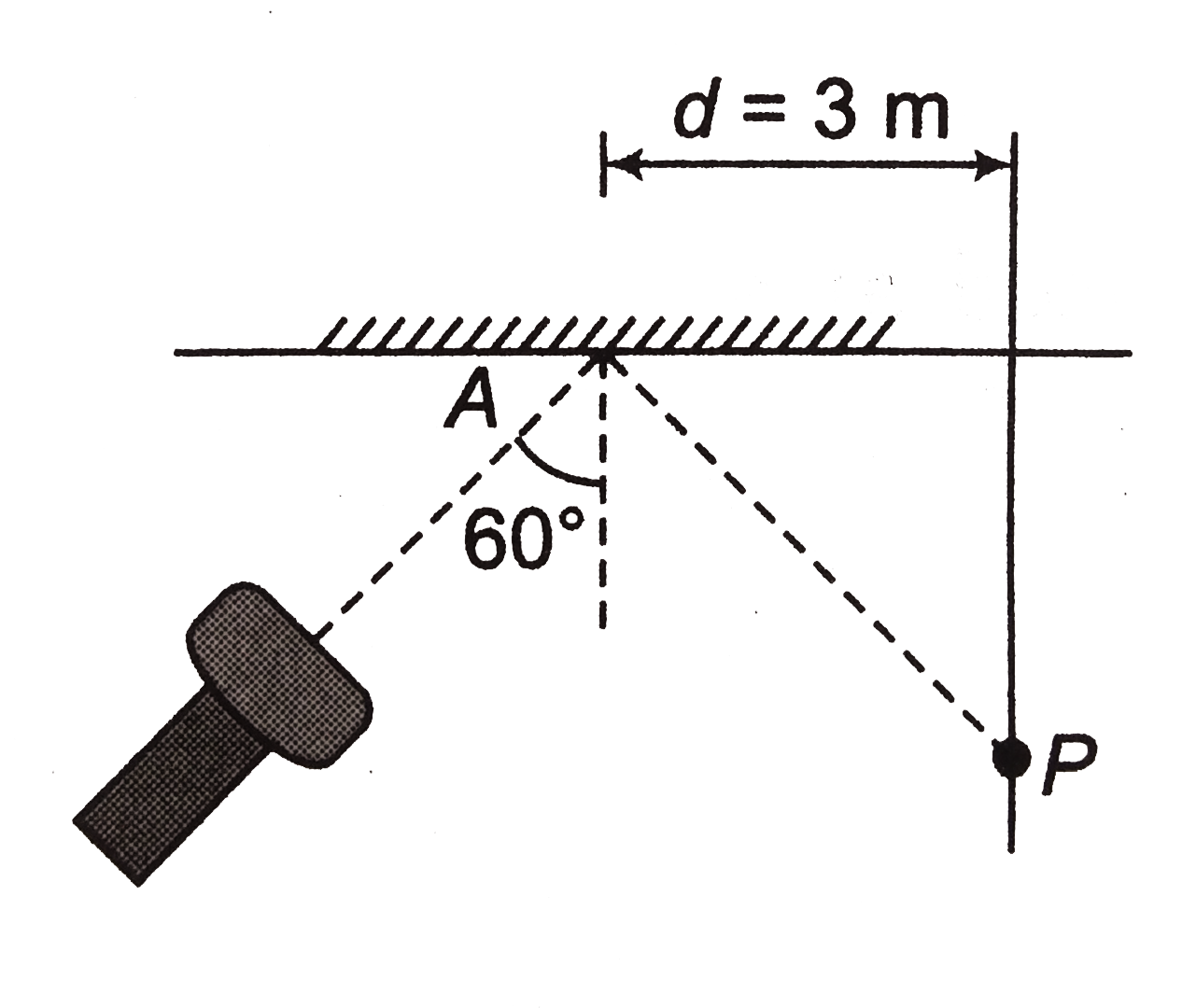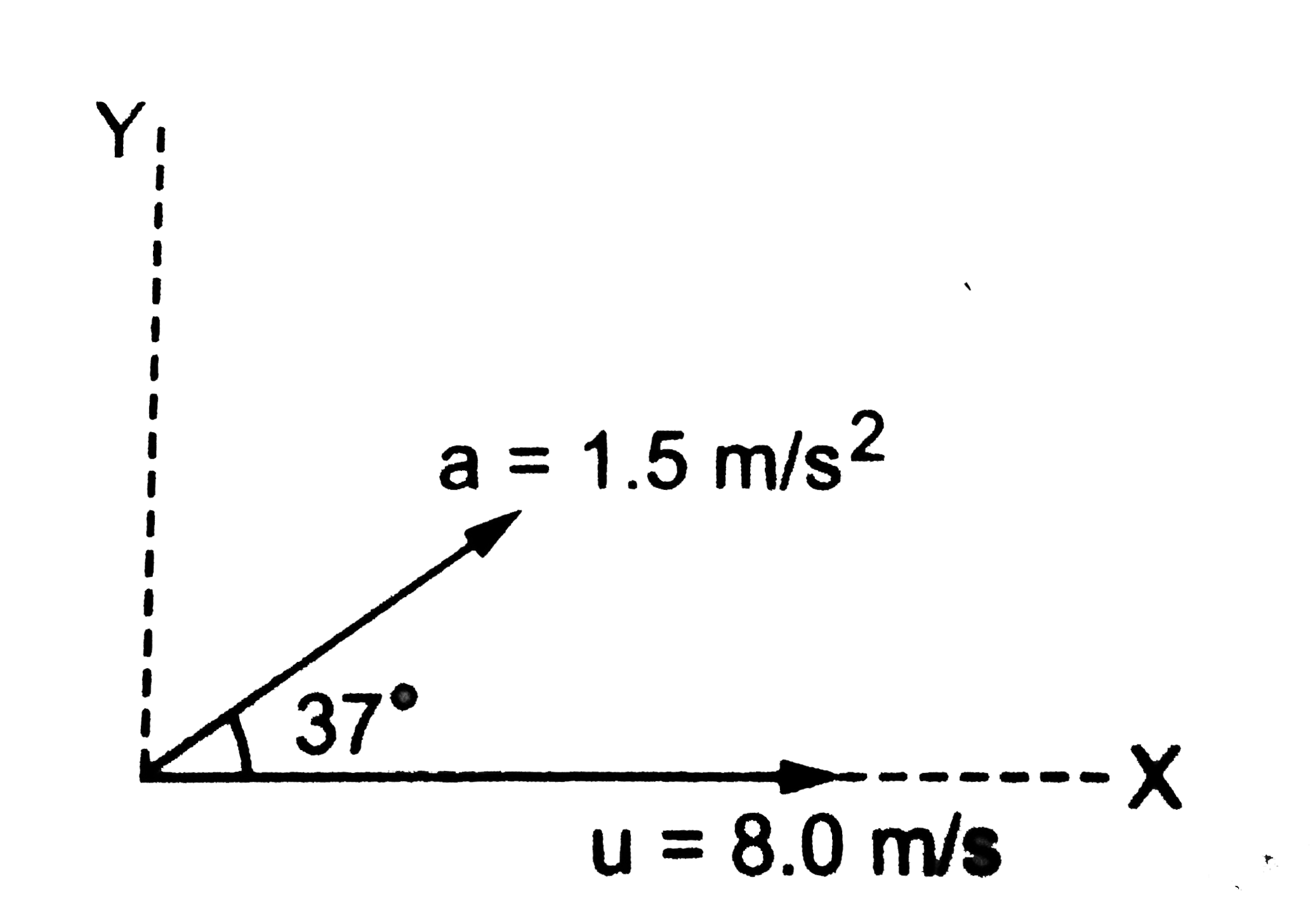Figure shows a torch producting a straight light beam falling on a plane mirror at an angle 60∘ The reflected beam makes a spot P on the screen along y-axis . If at t=0, mirror starts ratating about the hinge A with an angular velocity (ω)=1∘ per second clockwise. Find the speed of the spot on screen after time t = 15 s.

The correct Answer is:A, B
In 15 second, mirror will rotate 15∘ in clockwise direction.
Hence, the reflected ray will rotate (30∘) in clockwise direction


y=3tan(θ)
∴dydt=(3sec2θ).dθdt ...(i)
Here, dydt=(vp),dθdt=2∘ per second
=2×π180=π90 rad per second
At t=15s and (θ)=60∘
Substituting the values in Eq. (i), we have
vp={3sec260∘}{π90}
=3×4×π90
=2π15m/s.
Topper's Solved these Questions
- REFLECTION OF LIGHTBook:DC PANDEY ENGLISHChapter:REFLECTION OF LIGHTExercise:Level 2 Comprehensive Based
Explore 4 Videos
- RAY OPTICSBook:DC PANDEY ENGLISHChapter:RAY OPTICSExercise:Medical entrance gallary
Explore 76 Videos
- REFRACTION OF LIGHTBook:DC PANDEY ENGLISHChapter:REFRACTION OF LIGHTExercise:Level 2 Subjective
Explore 21 Videos
Similar Questions
Figure shows a torch producing a straight light beam falling on a plane mirror at an angle 60∘. The refected beam makes a spot P on the screen along y-axis. If at t=0 the mirror starts rotating about the hinge A with an angular velocity ω=1∘ per second clockwise, find the speed of the spot on screen after time t=15s

View SolutionFigure shows a plane mirror hinged at O and free to rotate in a vertical plane. The point O is at a distance x from a long screen. A beam of light moving vertically downwards is reflected by the mirror at O so that a bright spot P is formed at the screen. At the instant shown, the angle of incidence is θ and the mirror is rotating clockwise with constant angular veloity ω. Find the speed of spot P at this instant.

View SolutionFigure shows a solid transport semi cylinder of radius 10cm. A screen is placed at a distance 60cm from O. A narrow beam is incident along X−axis at O. If cylinder starts rotating about O in clockwise direction with angular speed 6rad/s spot formed on screen will move upward (Refractive index of material of cylinder=53)

What is initial angular velcity of ray refrected from plane surface.
View SolutionThe circuit shows a resistance, R=0.01Ω and inductance L=3mH connected to a conducting rod PQ of length l=1m which can slide on a perfectly conducting circular arc of radius l with its center at P. Assume that friction and gravity are absent and a constant uniform magnetic field b=0.1T exists as shown in the figure. At t=0, the circuit is seitched on a simultaneously an external torque is applied on the rod so that it rotates about P with a constant angular velocity ω=2rad/sec. Find the magnitude of this torque (inN-m) at t=(0.3In 2) second.

View SolutionA particle moves in the x-y plane with a constant acceleration of 1.5m/s2 in the direction making an angle of 37∘ with the x-axis.

At t=0 the particle is at the origin and its velocity is 8.0m/s along the x- aixs . Find the velocity and the position of the particle at t = 4.0s.
View SolutionA light ray I is incident on a plane mirror M.The mirror is rotated in the direction as shown in the figure by an arrow at frequency 9πrev/sec,The light reflected by the mirror is received on the wall W at a distance 10mfrom the axis of rotation .When the angle of incidence becomes 37∘find the speed of the spot (a point) on the wall?

View SolutionA particle movesin the X-Y plane with a constasnt acceleration of 1.5ms2 in the direction making an angle of 370 with the X-axis.At t=0 the particle is at the orign and its velocity is 8.0 m/s along the X-axis. Find the velocity and the position of the particle at t=4.0 s.

View SolutionThree particles A, B and C each of mass m, are connected to each other by three massless rigid rods to form a rigid, equilateral triangular body of side l. This body is placed on a horizontal frictionless table (x-y plane) and is hinged to it at the point A so that it can move without friction about the vertical axis through A . the body is set into rotational motion on the table about A with a constant angular velocity ω.

(a) Find the magnitude of the horizontal force exerted by the hinge on the body.
(b) At time T, when the side BC is parallel to the x-axis, a force F is applied on B along BC (as shown). Obtain the x-component and the y-component of the force exerted by the hinge on the body, immediately after time T.
View SolutionAt the centre of a fixed large circular coil of radius R a much smaller circular coil of radius r is placed .The two coils are concentric and are in the same plane .The larger coil carries a current I The smaller coil is set to rotate with a constant angular velocity ω about an axis along their common diameter .Calculate the emf induced in the smaller coil after a time t of its start of ratation
View SolutionFigure shows a circuit having a coil of resistance R=2.5Ω and inductance L connected to a conducting rod of radius 10cm with its center at P.

Assume that friction and gravity are absent and a constant uniform magnatic field of 5T exists as shown in figure. At t=0, the circuit is switched on and simultaneously a time-varying external torque is applied on the rod so that it rotates about P with a constant angular velocity 40rads−1. Find the magnitude of this torque (in mNm) when current reaches half of its maximum value. Neglect the self inductance of the loop formed by the circuit.
View Solution

